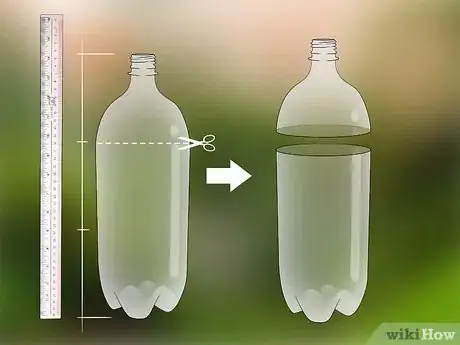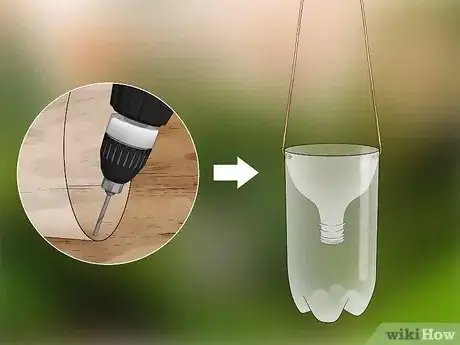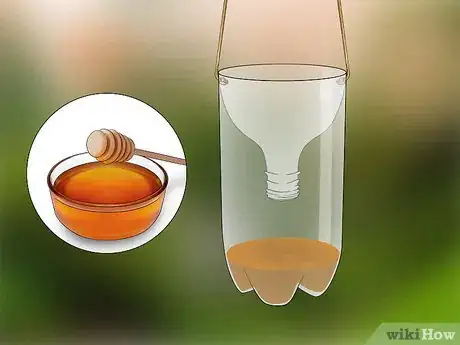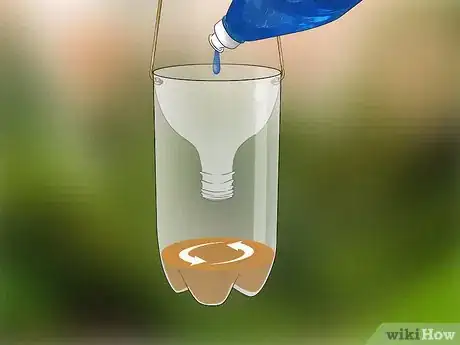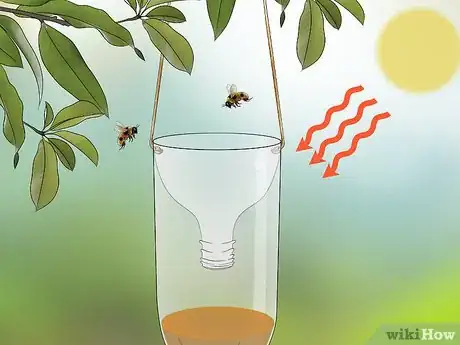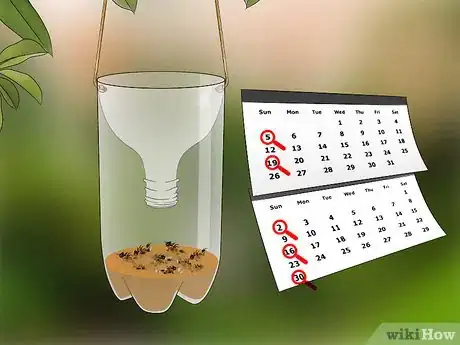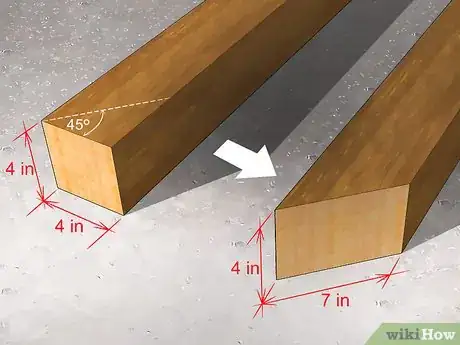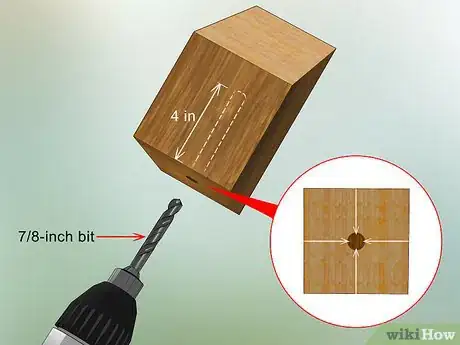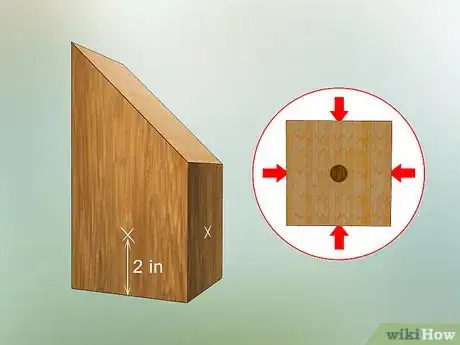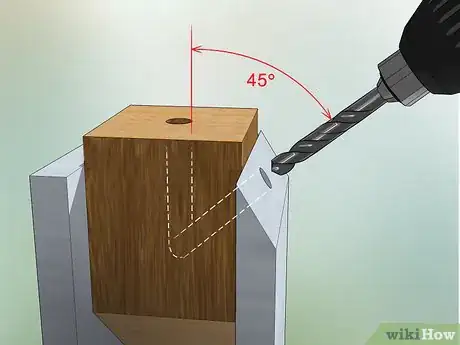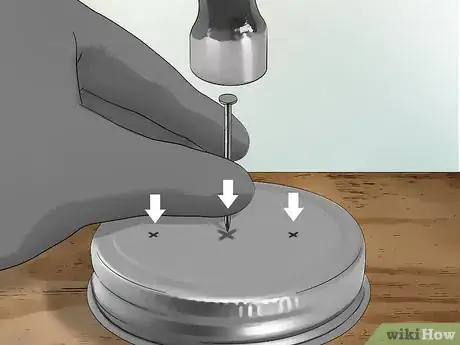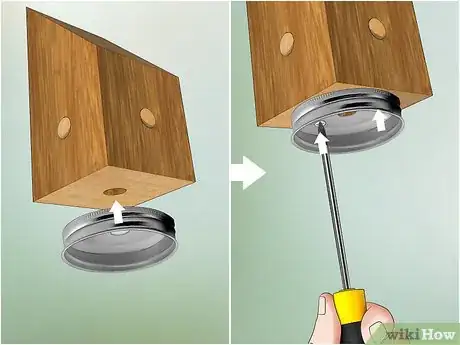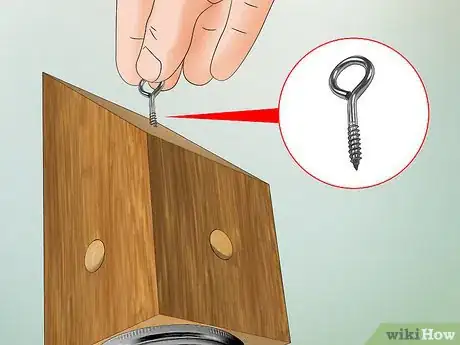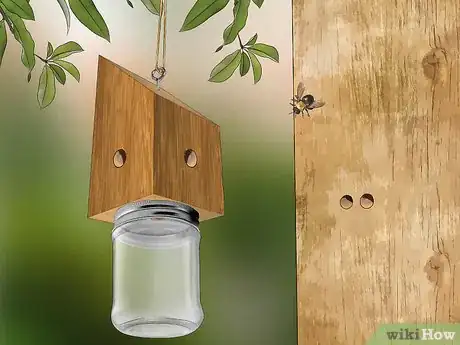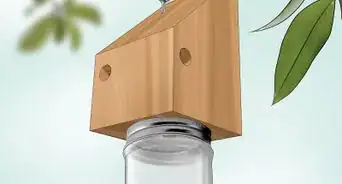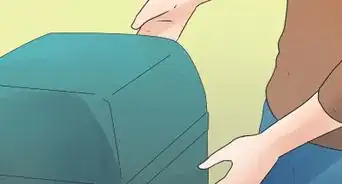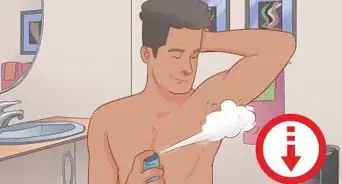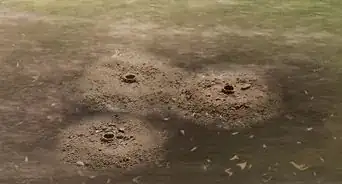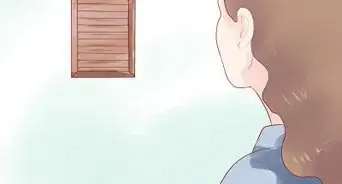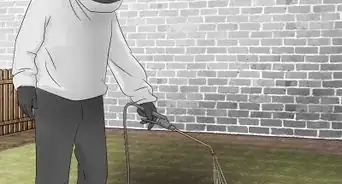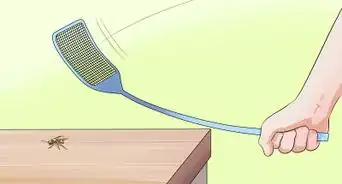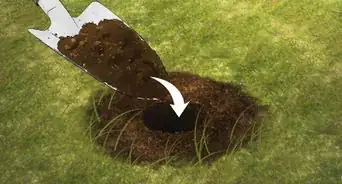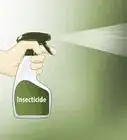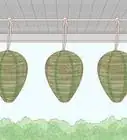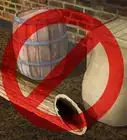This article was co-authored by Steve Downs. Steve Downs is a Live Honey Bee Removal Specialist, Honey bee Preservationist, and the Owner of Beecasso Live Bee Removal Inc, a licensed bee removal and relocation business based in the Los Angeles, California metro area. Steve has over 20 years of humane bee capturing and bee removal experience for both commercial and residential locations. Working with beekeepers, agriculturalists, and bee hobbyists, Steve sets up bee hives throughout the Los Angeles area and promotes the survival of bees. He has a passion for honeybee preservation and has created his own Beecasso sanctuary where rescued bee hives are relocated and preserved.
wikiHow marks an article as reader-approved once it receives enough positive feedback. In this case, 100% of readers who voted found the article helpful, earning it our reader-approved status.
This article has been viewed 224,188 times.
Bees and wasps are an important part of nature, but when these little critters are attracted to the sweet and savory foods in your home they can be a pest. If a colony has nested near your home, call a local bee removal company, but in the meantime, homemade bee traps made of 2-liter bottles will help manage bees and wasps that find their way into your home.[1] Carpenter bees, which bore holes into the wood of homes, will require a wooden trap with an attached mason jar base.
Steps
Using a 2-liter Soda Bottle
-
1Cut away the top third of a clean 2-liter soda bottle. Remove the cap. Use a utility knife to cut off the top of the bottle slightly below where the neck straightens. To cut an even line, wrap a piece of masking tape around the bottle to mark where you'll cut.[2]
-
2Invert the bottle top to nest it in the bottle bottom. Hold the bottle top so the capless end is facing downward. Insert this into the bottle bottom. Hold the bottle top in place at the top of the bottle bottom with your fingers. Staple the top to the bottom on four opposing sides.Advertisement
-
3Drill holes and add cord to make a hanging trap. Drill two holes an inch (2.5 cm) below the top of the trap, with each hole on opposite sides of the bottle. Use a drill bit large enough to allow your cord to pass through. Feed one end apiece of a length of cord into the two holes holes. Knot the ends of the cord and it's ready to hang.[5]
-
4Use honey or sugar water as bait. Pour honey or sugar water directly into the bottom of the trap. You don't need much; a thin layer will be enough to attract bees. Bees will be attracted to the sweetness and won't be able to escape, eventually dying in the trap.[6]
- Save the lives of bees by only using honey or sugar water. When you see a bee trapped inside, take it away from your home and carefully release it.[7]
-
5Poison bees with laundry soap. To ensure bees that enter your trap don't make it out alive, add a tablespoon (15 ml) of liquid laundry soap to your bait. Distribute the soap throughout the bait by stirring it with a utensil. The soap will poison and kill all bees that ingest it.[8]
-
6Position your traps near bee access points. Placing your traps too close to bee access points may actually draw more indoors. Prioritize locations in the sun. Sunlight will make the bait more effective and also cause bees to die in the trap faster.
- Hanging traps tend to attract bees better than ground traps. Ground traps, however, can be effective guarding window access points.[9]
-
7Check traps every two weeks. If you've fastened your bottle top and bottom with staples, you'll either need to remove the staples to clean and refill the trap or make a new one. Otherwise, remove the tape or clothespins, dump the contents of the trap, rinse it, and refill it with honey or sugar water.
- These traps will attract many kinds of insects, including ants. Use natural methods to prevent and remove ants.[10]
Building a Mason Jar Carpenter Bee Trap
-
1Mark a 45° angle on the 4x4 post. Lay your post flat on its long side. Use your square to draw a 45° angle from one corner of the post until the line ends at the opposite side edge. The angle, when cut, will form two edges about 7 in (17.8 cm) long and two that are about 4 in (10.2 cm) long.[11]
-
2Cut the post along the marked angle. Position your post somewhere it will be safe to cut with a saw. For example, you might clamp the unmarked edge to a workbench or scrap wood so you can cut the marked edge more easily. Cut the post along the marked angle with your circular saw.[12]
- Use caution when operating a saw. Improper usage can result in serious injury. Always wear safety glasses and a face mask.
- Substitute a hand saw for a circular saw. However, cutting with a hand saw will take longer and require more effort.
-
3Cut the opposite side of the post to finish incomplete cuts, if necessary. The blade of some saws might not extend all the way through the post. In this situation, turn the post over and mark the same angle on the opposite side. Cut the angle on the opposite side to finish the incomplete cut.
-
4Drill a hole in the flat bottom of the post.[13] Orient the flat bottom of your post, which is opposite the angled top, upwards. Use a tape measure and a pencil to mark the center of the flat bottom of the post. Use a 7/8-inch bit to drill a 4-inch (10.2 cm) deep hole at this center mark.[14]
- Drill the hole on a straight up and down angle with respect to the flat bottom of the carpenter bee trap.
- If you're a poor estimator of distance, measure the length of your drill bit and note the point it is about 4 in (10.2 cm) long. Drill to this point.[15]
-
5Mark entry holes on the four sides of the post. Each of the four sides will need a hole to make your trap most efficient. Use a tape measure and pencil to mark one hole on each side. Each hole should be 2 in (5 cm) from the bottom edge and ¾ in (1.9 cm) from side edges.[16]
-
6Drill side entry holes upward on a 45° angle.[17] Hold your square beside the hole to help you judge the angle. 45° is halfway between horizontal (flat) and vertical (up and down). Position your drill parallel to this angle and drill upward until the hole connects with the hole drilled in the bottom.[18]
- Drill holes in this fashion at each of the marked points on the four sides of your post. All holes should connect with the straight hole drilled in the center of the post's flat bottom.
- The angle for your side entry holes doesn't have to be perfect. For quick, easy, and accurate angled holes, use a pocket jig as a guide. Pocket jigs can be bought at hardware stores.[19]
Attaching the Mason Jar Base
-
1Mark the lid of your mason jar with a permanent marker. Remove the flat part of the mason jar from the circular threaded part that fastens it. Measure and mark the center point of the lid. Divide the distance between the middle point and the outer edge in half on both sides. Mark these two points as well.[20]
- The resulting three marks should form a straight line. The first mark will be the center of the lid, and the other two will be halfway between the center mark and the lid's outer edge.
-
2Punch holes into your lid. Position your punch on top of one of the marks. Swing a hammer with firm, moderate force and hit the end of the punch to drive its tip through the metal at your mark. Repeat this for the two remaining marks.
- Place the lid on a piece of scrap wood or heavy metal to prevent the punch from damaging your work surface.[21]
-
3Drill a hole in the center of the mason jar lid. Turn the lid over so the punched side is facing downwards. Drill a hole at the center punch with a ½-in metal drill bit. This will create metal shavings, which can be sharp. Dispose metal shavings in the garbage.[22]
- Drilling your center hole may have created metal burrs. Prevent cuts from these by removing them with a file.
-
4Attach the assembled jar lid onto the bottom of the post. Fit the lid into its circular, threaded part. Align the hole in the center of the lid with the hole in the flat bottom of the post. Attach the lid by fastening it to the post with a screw in each of the two remaining punched lid holes.[23]
-
5Add an eye screw on top and hang your trap. Measure and mark the center point of the angled top of your carpenter bee trap. Drill a screw hole here for your eye hook. Insert the eye hook, screw the glass jar into the attached lid mount, and hang it to trap and kill carpenter bees.[24]
-
6Hang traps close to active bee holes. Carpenter bees will be attracted to the holes in your trap and crawl inside it to lay eggs. However, the 45° angle of the entry tunnels will confuse the bees, drawing them into the glass jar where they can't escape.
- Close up carpenter bee holes while they're away with caulk, wooden dowels, or specialized carpenter bee killing foam.
- Closed nesting holes will force carpenter bees to look for the most convenient new home, like your carpenter bee trap.[25]
Expert Q&A
-
QuestionCan I use a box as a bee trap?
 Steve DownsSteve Downs is a Live Honey Bee Removal Specialist, Honey bee Preservationist, and the Owner of Beecasso Live Bee Removal Inc, a licensed bee removal and relocation business based in the Los Angeles, California metro area. Steve has over 20 years of humane bee capturing and bee removal experience for both commercial and residential locations. Working with beekeepers, agriculturalists, and bee hobbyists, Steve sets up bee hives throughout the Los Angeles area and promotes the survival of bees. He has a passion for honeybee preservation and has created his own Beecasso sanctuary where rescued bee hives are relocated and preserved.
Steve DownsSteve Downs is a Live Honey Bee Removal Specialist, Honey bee Preservationist, and the Owner of Beecasso Live Bee Removal Inc, a licensed bee removal and relocation business based in the Los Angeles, California metro area. Steve has over 20 years of humane bee capturing and bee removal experience for both commercial and residential locations. Working with beekeepers, agriculturalists, and bee hobbyists, Steve sets up bee hives throughout the Los Angeles area and promotes the survival of bees. He has a passion for honeybee preservation and has created his own Beecasso sanctuary where rescued bee hives are relocated and preserved.
Live Bee Removal Specialist Make a small opening in a cardboard or wooden box, then set it in an area out of harm's way. Lightly apply a few drops of lemongrass oil during spring—hopefully you'll capture a swarm!
Make a small opening in a cardboard or wooden box, then set it in an area out of harm's way. Lightly apply a few drops of lemongrass oil during spring—hopefully you'll capture a swarm! -
QuestionCan I paint the trap?
 Shibesh DhunganaCommunity AnswerYou can paint the trap if you want to. It won't make a big difference unless the paint has a very strong smell.
Shibesh DhunganaCommunity AnswerYou can paint the trap if you want to. It won't make a big difference unless the paint has a very strong smell. -
QuestionShould I put sugar water or honey in the jar as bait?
 Community AnswerYes, you'll need to add sugar water or the bees won't be attracted to your trap. The sugar is what attracts the bees. Don't use honey.
Community AnswerYes, you'll need to add sugar water or the bees won't be attracted to your trap. The sugar is what attracts the bees. Don't use honey.
Warnings
- Bee allergies can be quite serious. If you are allergic, keep medicine, like an EpiPen, close at hand in case of stings.⧼thumbs_response⧽
- Improper usage of tools could result in serious or permanent injury, especially for power tools like a circular saw.⧼thumbs_response⧽
- Although generally passive, bee swarms can be very dangerous when agitated. When working near or installing traps close to nesting locations, wait until night when bees aren't active. Avoid using flashlights or lanterns; light will attract bees.⧼thumbs_response⧽
Things You'll Need
2-liter Soda Bottle Trap
- 2-liter soda bottle (clean)
- Cordage (like paracord or nylon rope)
- Dish soap (optional)
- Drill (with drill bits)
- Honey (or sugar water)
- Masking tape (optional)
- Stapler (or clothespins)
- Utility knife
Carpenter Bee Trap
- ½″ metal bit
- ½″ wood bit
- 7” (17.8 cm) long 4×4 post
- 7/8″ wood bit
- Circular saw (or a hand saw)
- Clamp (optional)
- Drill
- Eye hook
- File (optional)
- Hammer
- Mason jar (half pint or regular pint)
- Pencil
- Punch
- Screw driver
- Square
- Tape measure
- Wood screws
References
- ↑ https://thebeeremoval.com/make-bee-trap-guide/
- ↑ https://www.apartmenttherapy.com/the-2-liter-soda-bottle-wasp-t-43290
- ↑ https://thebeeremoval.com/make-bee-trap-guide/
- ↑ https://www.apartmenttherapy.com/the-2-liter-soda-bottle-wasp-t-43290
- ↑ https://thebeeremoval.com/make-bee-trap-guide/
- ↑ https://www.apartmenttherapy.com/the-2-liter-soda-bottle-wasp-t-43290
- ↑ https://www.apartmenttherapy.com/the-2-liter-soda-bottle-wasp-t-43290
- ↑ https://thebeeremoval.com/make-bee-trap-guide/
- ↑ https://thebeeremoval.com/make-bee-trap-guide/
- ↑ https://thebeeremoval.com/make-bee-trap-guide/
- ↑ http://www.myfrugalhome.com/how-to-build-a-carpenter-bee-trap/
- ↑ http://www.thecountrychiccottage.net/make-a-carpenter-bee-trap/
- ↑ https://www.youtube.com/watch?v=sA64dCRb0uw
- ↑ http://www.thecountrychiccottage.net/make-a-carpenter-bee-trap/
- ↑ http://www.myfrugalhome.com/how-to-build-a-carpenter-bee-trap/
- ↑ http://www.thecountrychiccottage.net/make-a-carpenter-bee-trap/
- ↑ https://www.youtube.com/watch?v=sA64dCRb0uw
- ↑ http://www.myfrugalhome.com/how-to-build-a-carpenter-bee-trap/
- ↑ https://www.thespruce.com/how-to-drill-at-an-angle-1822332
- ↑ http://www.myfrugalhome.com/how-to-build-a-carpenter-bee-trap/
- ↑ http://www.myfrugalhome.com/how-to-build-a-carpenter-bee-trap/
- ↑ http://www.thecountrychiccottage.net/make-a-carpenter-bee-trap/
- ↑ http://www.myfrugalhome.com/how-to-build-a-carpenter-bee-trap/
- ↑ http://www.thecountrychiccottage.net/make-a-carpenter-bee-trap/
- ↑ http://www.myfrugalhome.com/how-to-build-a-carpenter-bee-trap/
About This Article
If a bee or a wasp has made its way into your home, you can easily catch it with a trap made from a plastic bottle. Cut off the top third of a clean 2-liter soda bottle, then invert the bottle top and push it down into the main body of the bottle. Staple the top of the bottle in place on at least 4 sides of the bottle. Drill two holes on opposite sides of the bottle about 1 inch (2.5 cm) below the top edge, then thread a cord through them and knot it on both ends to make a handle so you can hang the trap. Pour a little bit of honey or sugar water into the trap to make a shallow puddle at the bottom, then add about a tablespoon (15 mL) of dish soap. This will kill any bees or wasps that enter the trap. Position the trap in an area where the bee or wasp is likely to find it, such as near a sunny window. If you plan to use the trap over a long period of time, change out the bait and remove any dead insects once every 2 weeks. To learn how to make a bee trap with a mason jar and wooden posts, read on!
